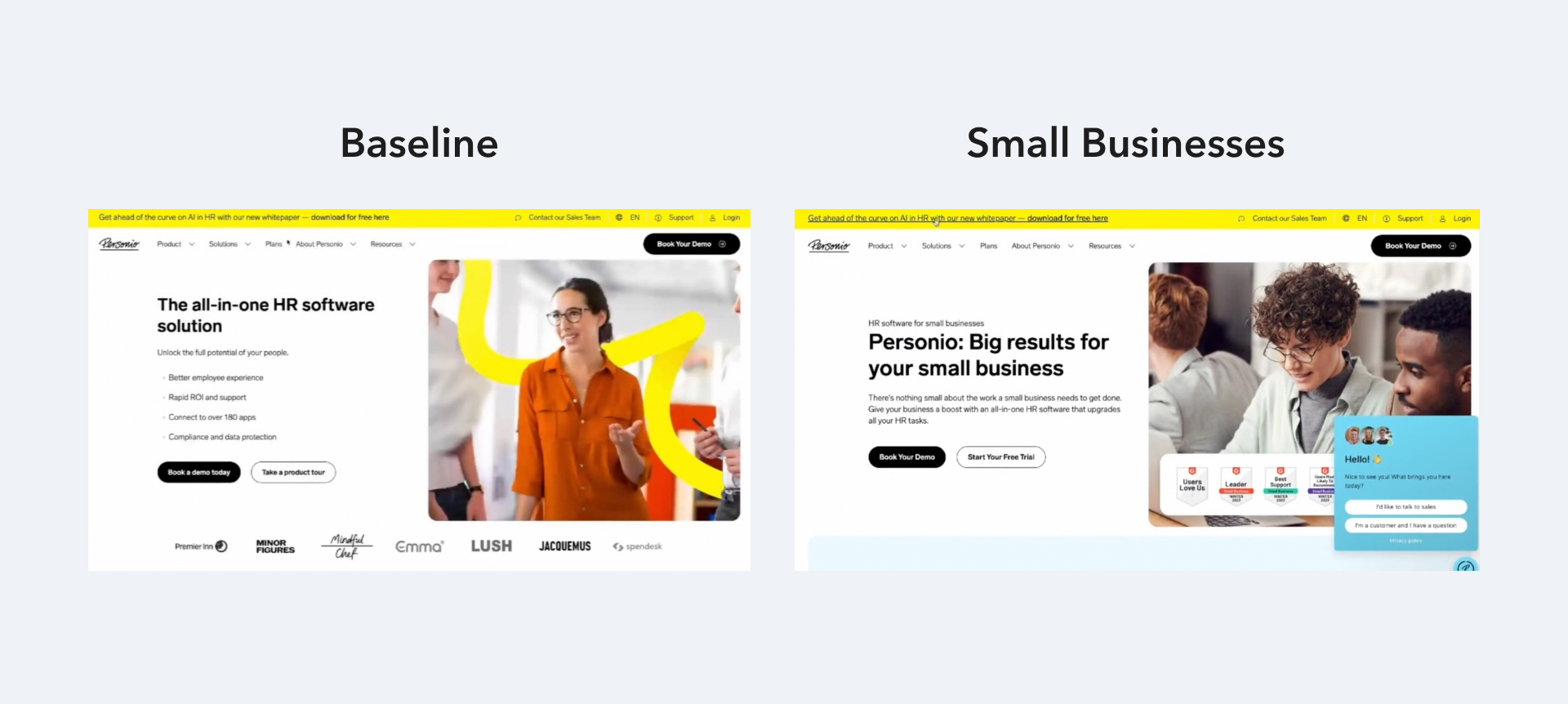
The Personalization guide
Web content personalization

Esat Artug
Updated: February 4, 2025

The Personalization guide
- 1. What is personalization and how to get started?
- 2. Web content personalization
- 3. Extend your reach with omnichannel personalization
- 4. Deliver personalized ecommerce experiences
- 5. Hyper-personalization: The next level of personalized content
- 6. How AI personalization can level up your marketing strategy
- 7. 5 powerful benefits of personalization
This is chapter 2 of the series, The Personalization guide
Summary
Web content personalization, also known as website personalization, is the process of tailoring your website's content to match the specific interests and needs of each individual visitor. You can do this by delivering personalized content to different audience segments or by changing the presentation of existing content to match individual visitor preferences.
For example, you might deliver personalized content by showing relevant products and services based on the user’s browsing history. Or you might present content in a different order, placing the most relevant content for each audience segment at the top of a landing page.
A strong web content personalization strategy empowers brands to tailor website content based on individual customers' needs, interests, and preferences. The result is highly personalized web pages that scream, “Hey, this is for you,” instead of bombarding users with unwanted and irrelevant information.
In this chapter, we'll reveal three benefits of website personalization and show you six impactful ways to personalize content on your website to increase engagement and customer loyalty.
3 benefits of personalizing website content
Web content personalization is an incredibly effective way to improve the overall user experience on your site and boost conversions.
1. Stand out from the crowd
By default, a one-size-fits-all message is generic. Users are likely hearing the same key benefits from you and your competitors. When you create personalized content, you use customer data and an understanding of individual customer behavior to create more unique experiences.
Website personalization crafts pages that speak directly to each target audience with messaging and images that resonate with them.
For example, Personio, an all-in-one HR software solution, wanted to engage enterprises and small to midsize businesses. Instead of a generic message, they used personalization to speak to each segment's specific pain points and needs. This enabled them to differentiate their messaging from the competition and boost conversion rates for both segments.

Personio’s personalized content helped them stand out and resulted in a 46% lift in conversion for the small business segment and a 45% lift for the enterprise segment.
2. Boost customer engagement and conversions
A successful content personalization strategy has the potential for significant returns.
Personalized content helps engage customers and increase conversions. One study found that personalized calls to action can increase conversion rates by as much as 202%.
In an example that’s a little closer to home, Ruggable, the original easy-to-clean carpet brand, traded a finicky custom-built personalization tool for the market-leading AI-native personalization platform Ninetailed by Contentful.
Among Ruggable’s many personalization successes was an initiative that showed personalized hero banners and pages to audience segments coming from an ad. For these individuals, click-through rates were 7x higher! Ruggable went on to personalize its homepage products based on email campaigns, resulting in a 25% increase in conversions.
3. Improve the user experience
Content personalization makes the entire customer journey feel more personal. When people see relevant content based on their browsing behavior, past interactions, past purchases, and their own preferences, they’re more likely to have a positive experience and become loyal customers.
Over the past 150 years, Kraft Heinz has built a base of loyal food lovers. To keep things fresh, Kraft Heinz shifted its focus from product information to creating personal connections through interactive quizzes and other personalized interactions.
This personal touch has delighted customers and increased engagement by over 30% for some Kraft Heinz brands.
“Having an infrastructure where we can design really delightful, personalized micro-interactions with them at scale makes a huge difference for customers.” - Justin Thomas, Head of Digital Experience, Kraft Heinz
Types of website personalization
A content personalization strategy increases the effectiveness of your website by delivering more personalized experiences to each target audience segment or individual.
Website content personalization uses data insights and experimentation to create tailored content that is more likely to engage customers and guide them to the products and features they are most interested in.
You can do this in a variety of ways, including delivering dynamic content based on geographic data, product recommendations based on browsing history, and refining search results based on contextual data.
Website content personalization can be as simple as changing the banner image on a landing page depending on a visitor’s geographic data or as complex as designing a custom product recommendation engine based on purchase history and previous interactions.
Some of the most common applications of personalized content in website personalization are:
-
Content personalization: Content personalization refers to dynamically tailoring content elements, such as hero images, page banners, buttons, or any other in-page modules.
-
Product/content recommendations: Show content or products based on user behavior, interactions, and previous data, such as purchase history.
-
Notifications: Companies can personalize notifications based on different users' interests, customer status, and other consumer data.
-
Menu personalization: Reorganizing or adjusting the order of the navigation bar depending on each visitor's needs, wants, and preferences.
-
Search personalization: Showing search results based on visitors' real-time website activity and search history.
6 places to deliver personalized content on your website
The best way to get started with website personalization is to experiment. Below are six places where a small amount of content personalization can yield big results. For more detailed examples of how companies personalize content, check out this post on website content personalization.
1. Greet users with a personalized headline
Landing pages are a great place to create content for different audiences and experiment with personalization. You can tailor headline messages for different customer segments using variables such as industry, location, season, company size, etc.
2. Experiment with personalized CTAs
Personalizing calls to action based on who will see the content improves the customer journey. Instead of bland "contact us," your CTAs can speak directly to potential customers with personalized content directing them to the next step in their customer journey. CTAs can be personalized based on sales funnel stage, target audience, customer status, etc.
3. Use personalized imagery to connect
Show your product in a local context, choose a hero image based on previous interactions, or customize a product image based on past purchases or geographic data. For example, instead of a generic picture of a truck, automotive dealers can create tailored images so people see images of the vehicles they’ve been browsing in locations similar to where they live.
4. Tailor featured content to each user
You can personalize featured content for every visitor based on specific attributes, including previous reading behavior, geographic and demographic data, or firmographic data, such as the industry. Featured content includes blog posts, ebooks, and social proof, such as testimonials, product reviews, and logos from users within the same industry or with similar attributes.
5. Keep users on track with personalized navigation
Companies can personalize the order of their navigation menu based on customer data and previous search inquiries. Personalized navigation and menu items aid in product discovery and help guide the user journey.
6. Product or feature personalization
Increase conversion by showing the right product or right features. Using what you know about your customer and their previous online interactions to intuit which products and features each user finds most appealing can help close that sale.
CMS personalization and AI tools make website personalization easier
CMS personalization — the ability to personalize experiences directly from within your content solution — and advances in AI-native personalization make content personalization at scale more accessible than ever.
See how CMS personalization and AI tools are helping brands personalize experiences and customer journeys directly within Contentful.
Up next: Omnichannel personalization
Learn how omnichannel personalization extends reach, maximizes ROI, and improves customer experiences. Explore key differences, examples, and strategies.
Written by

Esat Artug
Esat is Product Marketing Manager at Contentful and sharing his thoughts about personalization, digital experience, and composable across various channels.
